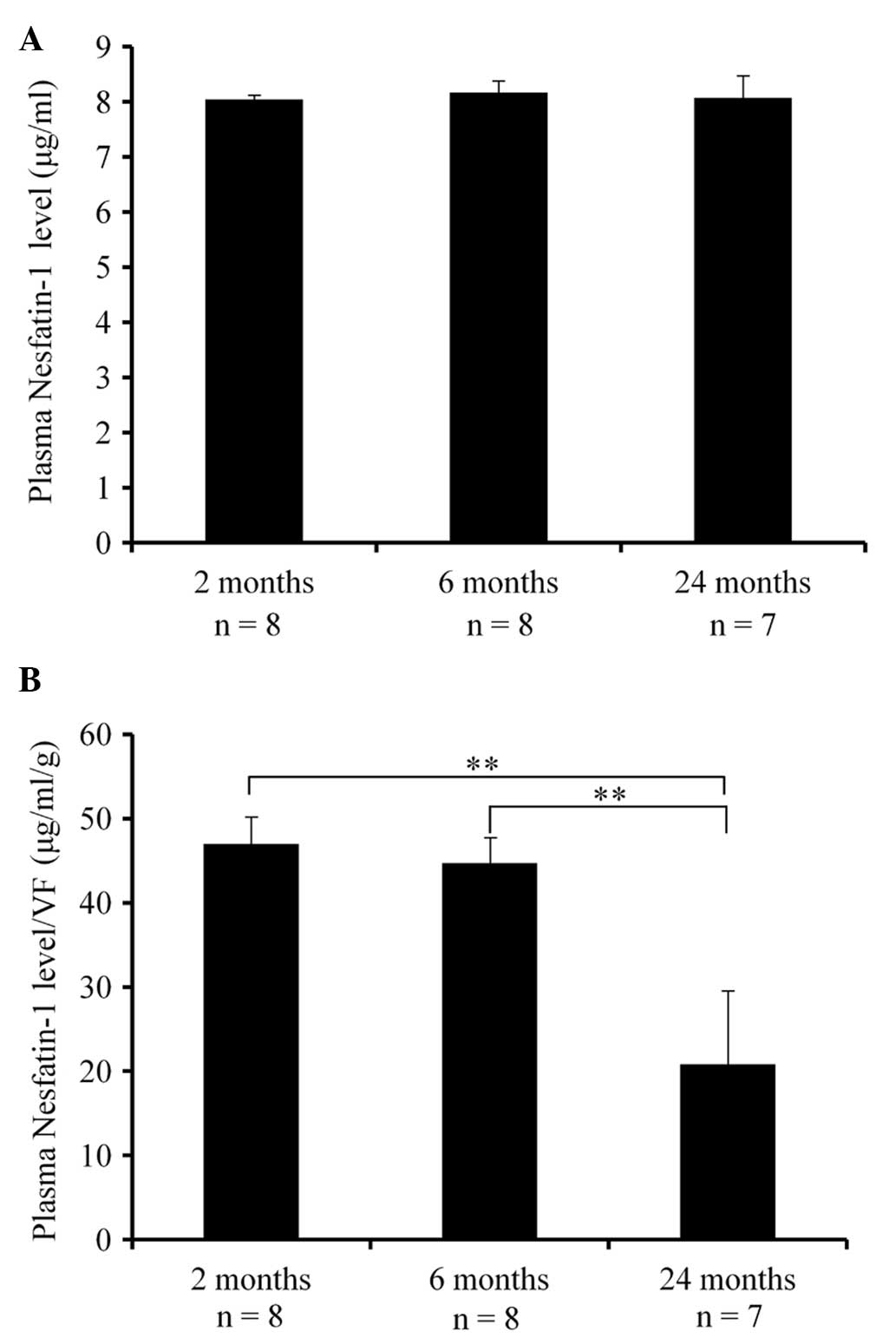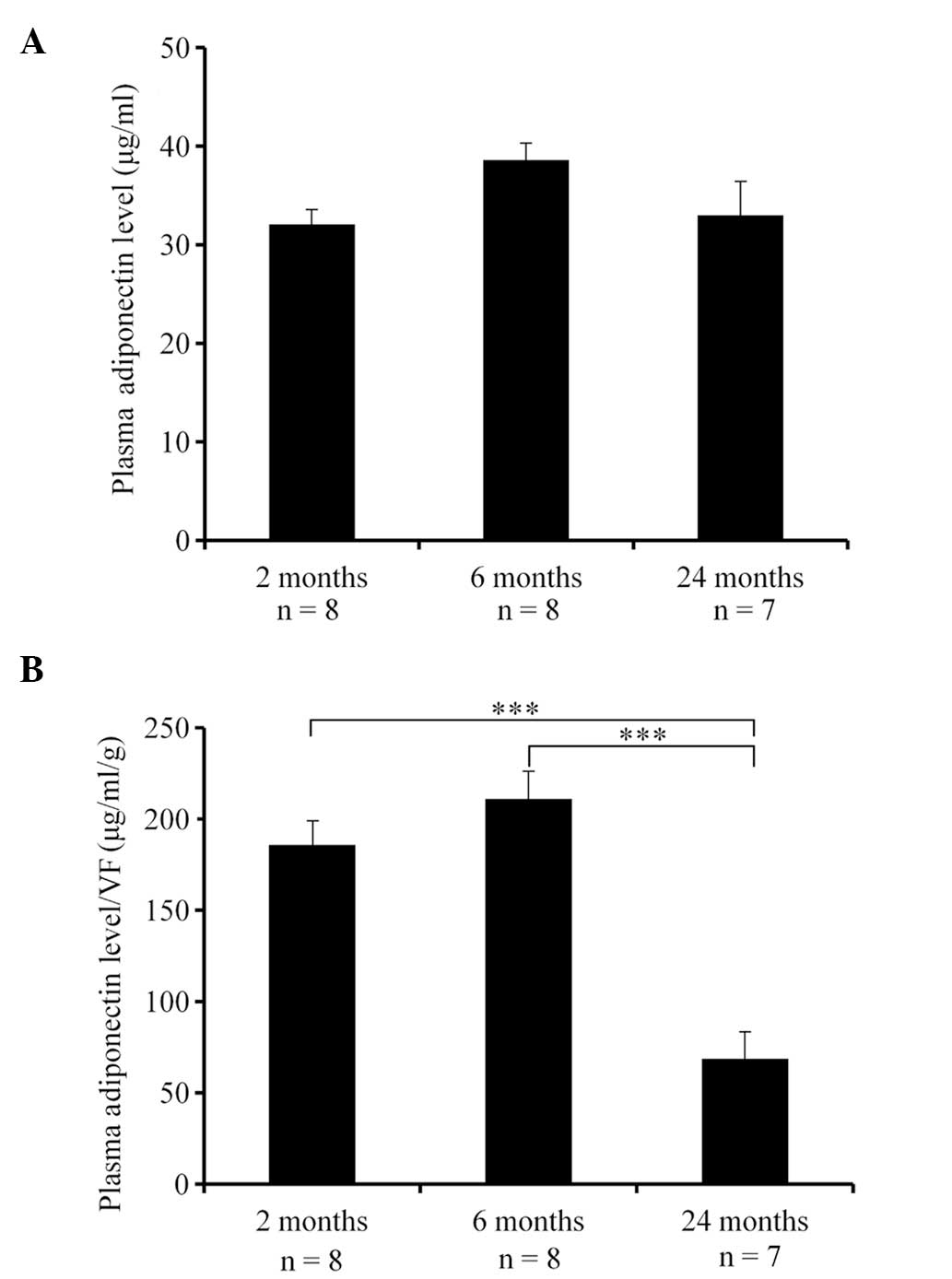|
1
|
Neary NM, Goldstone AP and Bloom SR:
Appetite regulation: from the gut to the hypothalamus. Clin
Endocrinol (Oxf). 60:153–160. 2004. View Article : Google Scholar : PubMed/NCBI
|
|
2
|
Sahu A and Kalra SP: Neuropeptidergic
regulation of feeding behavior Neuropeptide Y. Trends Endocrinol
Metab. 4:217–224. 1993. View Article : Google Scholar : PubMed/NCBI
|
|
3
|
Wynne K, Stanley S and Bloom S: The gut
and regulation of body weight. J Clin Endocrinol Metab.
89:2576–2582. 2004. View Article : Google Scholar : PubMed/NCBI
|
|
4
|
Wolden-Hanson T, Marck BT and Matsumoto
AM: Blunted hypothalamic neuropeptide gene expression in response
to fasting, but preservation of feeding responses to AgRP in aging
male Brown Norway rats. Am J Physiol Regul Integr Comp Physiol.
287:R138–R146. 2004. View Article : Google Scholar : PubMed/NCBI
|
|
5
|
Shklyaev S, Aslanidi G, Tennant M, et al:
Sustained peripheral expression of transgene adiponectin offsets
the development of diet-induced obesity in rats. Proc Natl Acad Sci
USA. 100:14217–14222. 2003. View Article : Google Scholar : PubMed/NCBI
|
|
6
|
Kadowaki T, Yamauchi T and Kubota N: The
physiological and pathophysiological role of adiponectin and
adiponectin receptors in the peripheral tissues and CNS. FEBS Lett.
582:74–80. 2008. View Article : Google Scholar : PubMed/NCBI
|
|
7
|
Oh-I S, Shimizu H, Satoh T, et al:
Identification of nesfatin-1 as a satiety molecule in the
hypothalamus. Nature. 443:709–712. 2006. View Article : Google Scholar : PubMed/NCBI
|
|
8
|
Ramanjaneya M, Chen J, Brown JE, Tripathi
G, Hallschmid M, et al: Identification of nesfatin-1 in human and
murine adipose tissue: a novel depot-specific adipokine with
increased levels in obesity. Endocrinology. 151:3169–3180. 2010.
View Article : Google Scholar : PubMed/NCBI
|
|
9
|
Zhang AQ, Li XL, Jiang CY, et al:
Expression of nesfatin-1/NUCB2 in rodent digestive system. World J
Gastroenterol. 16:1735–1741. 2010. View Article : Google Scholar : PubMed/NCBI
|
|
10
|
Su Y, Zhang J, Tang Y, et al: The novel
function of nesfatin-1: anti-hyperglycemia. Biochem Biophys Res
Commun. 391:1039–1042. 2010. View Article : Google Scholar : PubMed/NCBI
|
|
11
|
Stengel A, Goebel M, Wang L, et al:
Central nesfatin-1 reduces dark-phase food intake and gastric
emptying in rats: differential role of corticotropin-releasing
factor2 receptor. Endocrinology. 150:4911–4919. 2009. View Article : Google Scholar : PubMed/NCBI
|
|
12
|
Goebel M, Stengel A, Wang L, et al:
Nesfatin-1 immunoreactivity in rat brain and spinal cord autonomic
nuclei. Neurosci Lett. 452:241–246. 2009. View Article : Google Scholar : PubMed/NCBI
|
|
13
|
Ogiso K, Asakawa A, Amitani H, et al:
Plasma nesfatin-1 concentrations in restricting-type anorexia
nervosa. Peptides. 32:150–153. 2011. View Article : Google Scholar : PubMed/NCBI
|
|
14
|
Tan BK, Hallschmid M, Kern W, et al:
Decreased cerebrospinal fluid/plasma ratio of the novel satiety
molecule, nesfatin-1/NUCB-2, in obese humans: evidence of
nesfatin-1/NUCB-2 resistance and implications for obesity
treatment. J Clin Endocrinol Metab. 96:669–673. 2011. View Article : Google Scholar
|
|
15
|
Price CJ, Samson WK and Ferguson AV:
Nesfatin-1 inhibits NPY neurons in the arcuate nucleus. Brain Res.
1230:99–106. 2008. View Article : Google Scholar : PubMed/NCBI
|
|
16
|
Shimizu H, Oh-I S, Hashimoto K, et al:
Peripheral administration of nesfatin-1 reduces food intake in
mice: the leptin-independent mechanism. Endocrinology. 150:662–671.
2009. View Article : Google Scholar : PubMed/NCBI
|
|
17
|
Escobar CM, Krajewski SJ, Sandoval-Guzmán
T, et al: Neuropeptide Y gene expression is increased in the
hypothalamus of older women. J Clin Endocrinol Metab. 89:2338–2343.
2004. View Article : Google Scholar : PubMed/NCBI
|
|
18
|
Baranowska B, Bik W, Baranowska-Bik A, et
al: Neuroendocrine control of metabolic homeostasis in Polish
centenarians. J Physiol Pharmacol. 57(Suppl 6): 55–61.
2006.PubMed/NCBI
|
|
19
|
Baranowska B, Wolinska-Witort E, Bik W,
Baranowska-Bik A, et al: Evaluation of neuroendocrine status in
longevity. Neurobiol Aging. 28:774–783. 2007. View Article : Google Scholar : PubMed/NCBI
|
|
20
|
Stengel A and Taché Y: Nesfatin-1 - Role
as possible new potent regulator of food intake. Regul Pept.
163:18–23. 2010. View Article : Google Scholar : PubMed/NCBI
|
|
21
|
Stengel A, Goebel M, Yakubov I, et al:
Identification and characterization of nesfatin-1 immunoreactivity
in endocrine cell types of the rat gastric oxyntic mucosa.
Endocrinology. 150:232–238. 2009. View Article : Google Scholar : PubMed/NCBI
|
|
22
|
Li QC, Wang HY, Chen X, et al: Fasting
plasma levels of nesfatin-1 in patients with type 1 and type 2
diabetes mellitus and the nutrient-related fluctuation of
nesfatin-1 level in normal humans. Regul Pept. 159:72–77. 2010.
View Article : Google Scholar : PubMed/NCBI
|
|
23
|
Sahu A, Sninsky CA, Kalra PS, et al:
Neuropeptide Y concentration in microdissected hypothalamic regions
and in vitro release from the medial basal hypothalamus-preoptic
area of streptozotocin-diabetic rats with and without insulin
substitution therapy. Endocrinology. 126:192–198. 1990. View Article : Google Scholar
|
|
24
|
Wiliams G, Steel JH, Cardoso H, et al:
Increased hypothalamic neuropeptide Y concentrations in diabetic
rats. Diabetes. 37:763–772. 1988. View Article : Google Scholar : PubMed/NCBI
|
|
25
|
Ekblad E, Edvinsson L, Wahlestedt C, et
al: Neuropeptide Y co-exists and co-operates with noradrenaline in
perivascular nerve fibers. Regul Pept. 8:225–235. 1984. View Article : Google Scholar : PubMed/NCBI
|
|
26
|
Lundberg JM, Hua X and Franco-Cereceda A:
Effects of NPY on mechanical activity and neurotransmission in the
heart, vas deferens and urinary bladder of the guinea-pig. Acta
Physiol Scand. 121:325–332. 1984. View Article : Google Scholar : PubMed/NCBI
|
|
27
|
Wang H, Qiu Q, Tan LL, et al: Prevalence
and determinants of diabetes and impaired fasting glucose among
urban community-dwelling adults in Guangzhou, China. Diabetes
Metab. 35:378–384. 2009. View Article : Google Scholar : PubMed/NCBI
|
|
28
|
Kim KI, Chang HJ, Cho YS, et al: Current
status and characteristics of hypertension control in community
resident elderly Korean people: data from a Korean longitudinal
study on health and aging (KLoSHa study). Hypertens Res. 31:97–105.
2008. View Article : Google Scholar : PubMed/NCBI
|
|
29
|
Koh SJ, Hyun YJ, Choi SY, et al: Influence
of age and visceral fat area on plasma adiponectin concentrations
in women with normal glucose tolerance. Clin Chim Acta. 389:45–50.
2008. View Article : Google Scholar : PubMed/NCBI
|
|
30
|
Atzmon G, Pollin TI, Crandall J, et al:
Adiponectin levels and genotype: a potential regulator of life span
in humans. J Gerontol A Biol Sci Med Sci. 63:447–453. 2008.
View Article : Google Scholar : PubMed/NCBI
|
|
31
|
Takenouchi Y, Kobayashi T, Matsumoto T, et
al: Gender differences in age-related endothelial function in the
murine aorta. Atherosclerosis. 206:397–404. 2009. View Article : Google Scholar : PubMed/NCBI
|
|
32
|
Yamauchi T, Kamon J, Waki H, et al: The
fat-derived hormone adiponectin reverses insulin resistance
associated with both lipoatrophy and obesity. Nat Med. 7:941–946.
2001. View Article : Google Scholar : PubMed/NCBI
|
|
33
|
Sheng T and Yang K: Adiponectin and its
association with insulin resistance and type 2 diabetes. J Genet
Genomics. 35:321–326. 2008. View Article : Google Scholar : PubMed/NCBI
|
|
34
|
Yamauchi T, Kamon J, Minokoshi Y, et al:
Adiponectin stimulates glucose utilization and fatty acid oxidation
by activating AMP-activated protein kinase. Nat Med. 8:1288–1295.
2002. View Article : Google Scholar : PubMed/NCBI
|
|
35
|
Kadowaki T and Yamauchi T: Adiponectin and
adiponectin receptors. Endocrine Rev. 26:439–451. 2005. View Article : Google Scholar : PubMed/NCBI
|
|
36
|
Goldstein BJ and Scalia R: Adiponectin: a
novel adipokine linking adipocytes and vascular function. J Clin
Endocrinol Metab. 89:2563–2568. 2004. View Article : Google Scholar : PubMed/NCBI
|












